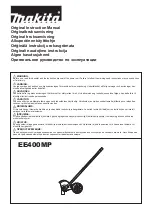
This is simply an unbalanced "Send and Return" jack on the rear
panel. It allows you to patch any other pieces of equipment into
the signal path, such as an effects processor or noise gate. To use
it you will need a "Y" lead wired as follows:
Tip: send
Ring: return
Sleeve: ground
When no jack is inserted, the socket is internally linked, or
"normalled", so that the signal flows uninterrupted. Note that the
Insert Point is after the Preamp in the signal path but before the
Compressor and Meequalizer.
The VU bargraph meter displays one of two things, depending on
the setting of the 'PRE' switch.
In VU mode ('PRE' switch out), the Meter shows the signal level at
the XLR Output, after the 'OUTPUT GAIN' fader. Note that this is
relative to the operating level of "+4dBu", so if the meter reads "0",
then you will have +4dBu coming out of the XLR.
(In the case of the 1/4" jack output socket, if you have selected
"
+4dBu
" using the Rear Panel switch and the meter reads "0",
then you will have +4dBu coming out of the jack socket. If you
have selected "
-10dBv
" using the Rear Panel switch and the
meter reads "0", then you will have -10dBv coming out of the
output jack).
"PRE" mode ('PRE' switch in), allows the output of the Preamp to
be metered directly, rather like the "PFL" button on a mixing
console. This is useful for adjusting the gain of the Preamp.
A separate "GR" bargraph meter in the Compressor measures
Gain Reduction. Whenever the compressor reduces the gain of a
signal, the meter moves "backwards" to show the amount of gain
reduction taking place at any moment. Note that unlike many
other products, in the sixQ
2
this reading is a true measurement of
gain reduction, derived by comparing the input and output of the
PhotoOptical gain cell.
The hardest device to understand, yet one of the most useful, the
PhotoOptical Compressor is what gives Joemeek products their
unique character. Its job is to make quiet sounds louder and loud
sounds quieter, or in other words to reduce the dynamic range of
the programme material. It's a bit like manually riding the volume
control, except the compressor does it automatically, responding
far quicker and more accurately than you ever could by hand. The
compressor is applied in several ways:
1. Make Sounds Stand Out
Because compressors make loud sounds quieter, you can boost
the volume of the quiet bits without the loud bits getting even
louder. That means you can raise the average level of an
instrument or vocal in the mix, which has the effect of lifting it and
bringing it forwards. This can actually improve vocals for
example, bringing them out in front of a mix, making them sound
denser, more even, and more confident!
2. Crank Up The Volume
Raising the average volume of whole mixes means they can be
heard in noisy environments, such as vehicles and factories.
Boosting the average level is what makes radio stations sound
LOUD and the same technique is used on TV commercials too,
which is why they always seem annoyingly louder than the movie
you were trying to watch!
3. Protection
Fast response times are generally used to control brief transients.
In other words if an occasional peak sticks its head above a
maximum permitted level, the compressor clobbers it; this is
known as limiting and a compressor designed solely for this
purpose is known as a Limiter. Limiters are primarily used to
protect recorders and monitor systems from overload, radio
transmitters from overmodulation, etc. The Joemeek compressor
is not primarily intended for this purpose as the Attack is not really
fast enough to satisfy radio station requirements, although it is
generally good enough to protect recorders and monitors, where
the effect of transients is less critical. Normally you should not
hear a limiter operating but if it is driven hard constantly, it can
render a mix somewhat flat and lifeless.
4. Accommodation
The dynamic range of the human ear is phenomenal, extending
from the threshold of hearing (eg: a pin dropping onto soft carpet)
to threshold of pain (eg: standing next to a jet aircraft) - some
120dBA in all. By contrast, vinyl, cassette tape and radio
broadcasts all have a dynamic range of about half that. Since the
advent of the CD, the dynamic range of the medium is far less of
an issue and compressors are used more to give a certain "feel"
to a production. AM and FM radio however, is still very much
compressed to fit its restricted dynamic range.
5. Modification
A compressor can change the dynamics, or "envelope" of the
track and it is here that the Joemeek Compressor excels!
Insert Point
Meters
Compressor
8
































